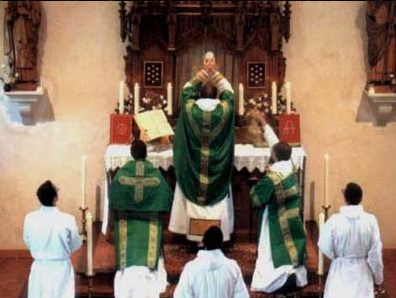
Biretta tip to Subdeacon Ben Andersen (http://occidentalis.blogspot.com/)
Origin and developmentThe question of a special unified rite for the order received no official attention in the time of St. Dominic, each province sharing in the general liturgical diversities prevalent throughout the Church at the order's confirmation in 1216. Hence, each province and often each convent had certain peculiarities in the text and in the ceremonies of the Holy Sacrifice and the recitation of the Office.The first indication of an effort to regulate liturgical conditions was manifested by Jordan of Saxony, the successor of St. Dominic. The first systematic attempt at reform was made under the direction of John the Teuton, the fourth master general of the order. At his suggestion the Chapter of Bologna (1244) asked the delegates to bring to the next chapter (Cologne, 1245) their special rubrics for the recitation of the Office, their Missals, Graduals and Antiphonaries, "pro concordando officio". To bring some kind of order out of chaos a commission was appointed consisting of four members, one each from the Provinces of France, England, Lombardy, and Germany, to carry out the revision at Angers. They brought the result of their labours to the Chapter of Paris (1246), which approved the compilation and ordered its exclusive use by the whole Order and approved the "Lectionary" which had been entrusted to Humbert of Romains for revision. Another force preservative of the special Dominican Rite was the Decree of Pius V (1570), imposing a common rite on the universal Church but excepting those rites which had been approved for two hundred years. This exception gave to the Order of Friars Preachers the privilege of maintaining its old rite, a privilege which the chapters of the order sanctioned and the members of the order gratefully accepted.Several times movements have been started with the idea of conforming with the Roman Rite; but these have always been defeated, and the order still preserves the rite conceded to it by Pope Clement in 1267. [NLM: until our own modern day of course with the adoption of the Pauline Missal by the Dominican Order]The Dominican Rite, formulated by Humbert, saw no radical development after its confirmation by Clement IV. When Pius V made his reform, the Dominican Rite had been fixed and stable for over three hundred years, while a constant liturgical change had been taking place in other communities. Furthermore the comparative simplicity of the Dominican Rite, as manifested in the different liturgical books, gives evidence of its antiquity.The collection of the liturgical books now contains: (1) Martyrology; (2) Collectarium; (3) Processional; (4) Antiphonary; (5) Gradual; (6) Missal for the conventual Mass; (7) Missal for the private Mass; (8) Breviary; (9) Vesperal; (10) Horæ Diurnæ; (11) Ceremonial. With the exception of the Breviary, these books are similar in arrangement to the correspondingly named books of the Roman Rite.
Read the rest of the article here: http://thenewliturgicalmovement.blogspot.com/2006/11/dominican-rite-summary.html
No comments:
Post a Comment